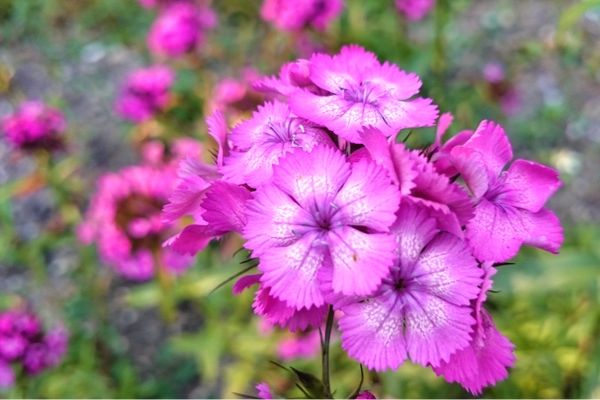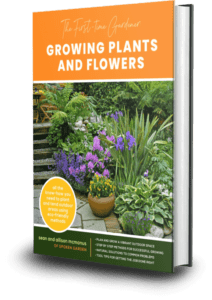Learn Dianthus care in this mini plant profile so you can help them thrive year after year (and attract tons of fall pollinators)!

Fall-blooming flowers have so much to offer. Adding color and beauty to your fall garden, they’ll reward you and help you transition from your prolific summer garden into the cooler months of fall and winter.
This quick podcast will cover quick, efficient Dianthus care so that you can enjoy your Dianthus plants and see different tools you might need to help you plant this fall, quickly.
This episode is perfect for a beginning gardener or new homeowner who wants to learn useful tips about caring for your Dianthus plants.
Dianthus Plant Care
A fall favorite, these vibrant and showy plants will bloom periodically or continually, depending on the species throughout most of the spring, summer, and into the fall with proper care. Plus, they’ll attract many different pollinators and require very little maintenance.
Dianthus Quick Facts:
- In the Caryophyllaceae family.
- Are considered an annual, biennial or perennial, depending on species and your climate zone.
- Also known as Carnations of Sweet Williams.
- Have small to medium-sized flowers.
- Flowers come in white, pink, rose, red, yellow, white, and orange.
- Mainly bloom from spring to early summer. Some will rebloom later in the season or keep blooming into the fall.
- Generally, most species and types grow in Sunset= Zones A2, A3, and 1 to 24. USDA= Hardy to zones 3 to 9.
- They prefer full sun in most climates and then light shade in hotter climates.
- Thrive in light, fast-draining soil, but some need more of a rocky type while others need a richer soil.
- These plants need regular watering and don’t overwater them.
- Native to Eurasia, Southern Europe, Mediterranean, and China.
- Need low to minimal maintenance, with mainly some dead-heading to prolong flowering.
- They can be divided once mature.
[convertkit form=1114562]
Plant Care Supplies
Dianthus are perfect for beginners to more experienced gardeners due to their variety of shapes, sizes, and colors. It’s no wonder they are one of the favorites of the fall garden.
Now that you have learned a bit about their maintenance requirements, you need the proper tools for caring for them. This is a crucial step along your journey to thorough Dianthus plant care, almost as important as choosing the plants themselves. The question is do you have all the tools you need?
If not, below are some recommendations to specific tools we use that will support your Dianthus plant maintenance. Or, if you need to shop for other garden plants for this summer or fall, click here to find what you need!
1) For Planting
2) For Watering
You’ll need some type of garden hose for your plants and this is one of the highest-rated on Amazon from Flexzilla. It is flexible, durable, and comes in multiple lengths for whatever size your yard.
Here’s a huge time-saving tip, set up a drip hose and a water timer so you don’t have to waste time, water, or money hand watering your plants.
We love this water timer by Orbit because it is easy to set up, has a manual override option for when you need your hose, and features two hose attachments which is awesome.
3) For Deadheading or Trimming
You will need a good, sturdy pair of pruning shears and these are the best in our opinion! These pruning shears from Corona are super sharp and stay sharp.
These would be perfect for deadheading, snipping, or other general light pruning tasks. We use ours all the time!
Flower Books
If you’re looking for further educational resources about all types of perennials, these books below are great educational references!
American Horticultural Society Encyclopedia of Plants and Flowers
This is a great reference guide for tons of plants from the American Horticultural Society.

Floret Farm’s Cut Flower Garden: Grow, Harvest, and Arrange Stunning Seasonal Blooms
This book has stunning images, how-tos, and planting information to grow your own cutting garden.

Or, if you need to shop for other garden plants for this fall, click here to find what you need!
Conclusion for Dianthus Care
The Dianthus plant and its gorgeous flowers will reward you with beautiful garden color and the pollinators with a food source during many seasons.
Armed with your new knowledge of plant care, your plants can thrive for months to come.
Now we want to hear from you!
What other questions do you have about your Dianthus? Let us know by leaving a quick comment below. Thanks!
That’s all for this DIY garden minute episode!
You can find other one-minute topics on our podcast page at spokengarden.com/podcast
Find us on Instagram or Pinterest to follow or leave us a comment. We would love to hear from you!
Also, find us on your favorite podcast platform and Alexa through MyPod or AnyPod.
And hey—before you head out—if you want to connect with us and subscribe to our newsletter go to our free resource page!
We have FREE garden content we are so excited to give to you, like cheat sheets, plant profile sheets, etc!
Thanks for Listening!!!
Share Your Thoughts:
- Leave a note in the comment section below.
- Leave comments/ suggestions at Seanandallison@eseospace.dev
- Share our show on Twitter, Facebook, or Pinterest.
To Help Out The Show:
- Leave a review on iTunes. Your ratings and reviews really help us out!
- Subscribe on iTunes or Spotify.

*Spoken Garden is a participant in the Amazon Services LLC Associates Program, an affiliate advertising program designed to provide a means for sites to earn advertising fees by advertising and linking to Amazon.com.
Learn Dianthus care in this mini plant profile so you can help them thrive year after year (and attract tons of fall pollinators)!
Subscribe on iTunes
Today’s Topic:
Dianthus Care
In this podcast, you’ll learn how to properly care for the Dianthus in your fall garden
What You’ll Learn:
- Quick facts about our featured plant.
- Links to buy helpful garden mum tools.
- Links for further resources or education.
Resources:
Some of the resources and products below may be affiliate links, meaning we might get paid a commission (at no extra cost to you) if you use that link to make a purchase.
- Dianthus: A Gardener’s Guide and Plant Profile
- Dianthus Free Plant Reference Guide
- Chrysanthemum Care – DIY Garden Minute Ep. 114
- Daffodil: Gardener’s Guide and Plant Profile
- Planting Iris Bulbs – DIY Garden Minute Ep. 107
Downloads:
Free Fall Gardening chapter from our ebook, “Four-Season Gardening”.






